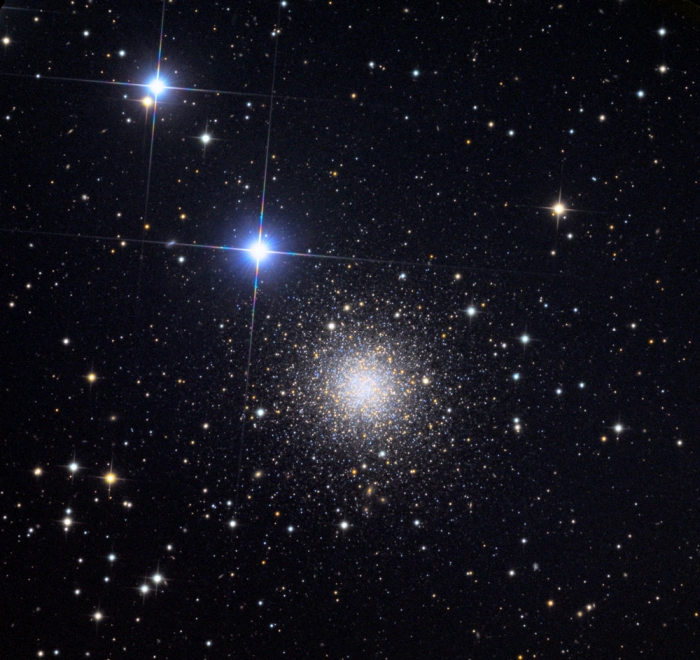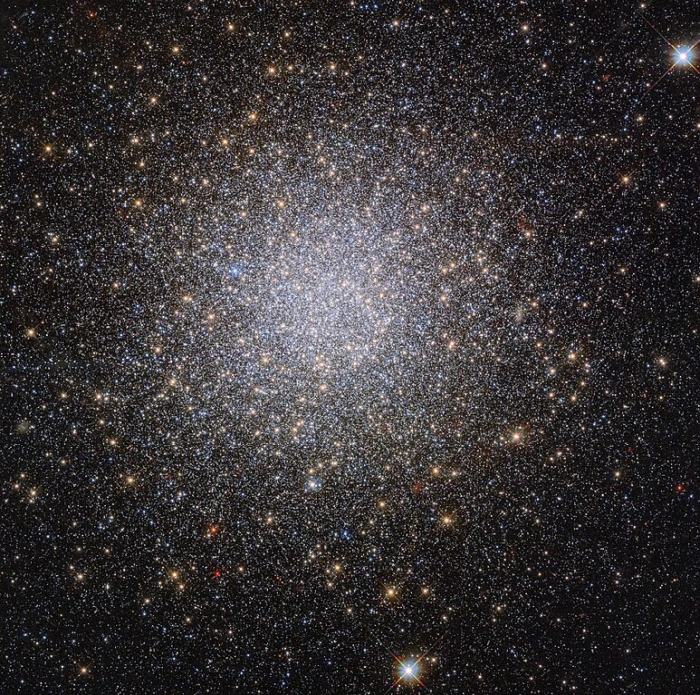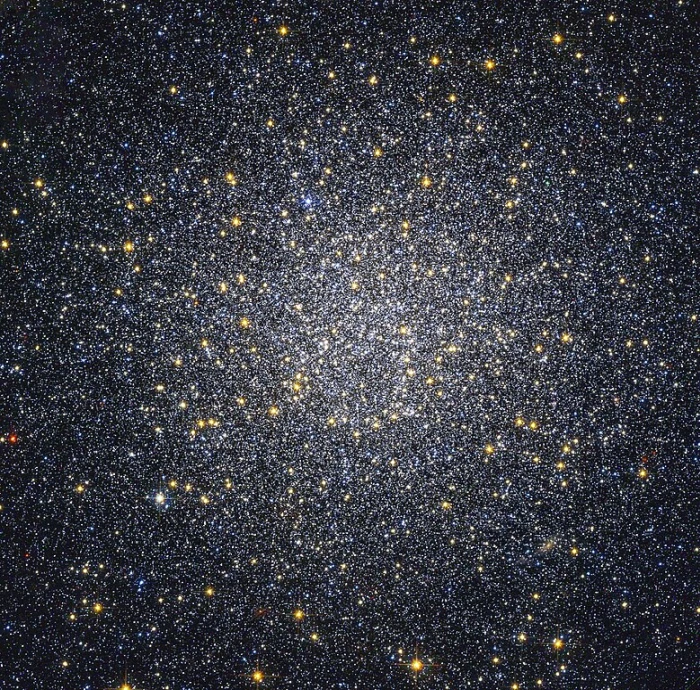The Intergalactic Wanderer (NGC 2419) is a distant but relatively bright globular cluster located approximately 275,000 light-years away in the constellation Lynx. With an apparent magnitude of 9.6 and an apparent size of 6 arcminutes, it can be seen in amateur telescopes. The cluster is listed as Caldwell 25 (C25) in the Caldwell catalogue.
NGC 2419 lies at a similar distance from the Galactic center – around 300,000 light-years – as it does from the solar system. The remote cluster was once believed not to be orbiting around the Milky Way galaxy, which led to the nickname the Intergalactic Wanderer. It is now considered to be part of the Milky Way, even though it gets farther away from the Milky Way center than the Magellanic Clouds as it orbits our galaxy. In comparison, the Large Magellanic Cloud lies 163,000 light-years away and the Small Magellanic Cloud is 203,700 light-years away.
The star cluster takes around 3 billion years to complete an orbit around the Milky Way. Unlike most known globular clusters, which lie in the direction of the Galactic centre, NGC 2419 lies in the direction of the Andromeda Galaxy, the Milky Way’s largest neighbour.

Intergalactic Wanderer (NGC 2419), image credit: Adam Block/Mount Lemmon SkyCenter/University of Arizona (CC BY-SA 3.0)
The Intergalactic Wanderer is a Shapley class VII cluster, indicating an intermediate loose concentration of stars towards the centre. Other bright class VII clusters include the Great Sagittarius Cluster (M22) and the Chandelier Cluster (NGC 6723) in the constellation Sagittarius, Messier 10 and NGC 6287 in Ophiuchus, NGC 5694 (Caldwell 66) in Hydra, and NGC 5986 in Lupus.
The Intergalactic Wanderer is one of the most massive and most luminous globular clusters in the Milky Way. It has a mass of 900,000 solar masses and an absolute magnitude of -9.42. With a radius of 260 light-years, it is both larger and more massive than the Hercules Globular Cluster (Messier 13), the Great Pegasus Cluster (Messier 15), 47 Tucanae (NGC 104), and the Great Sagittarius Cluster (Messier 22).
The cluster is, however, not as massive as the record holder Omega Centauri (NGC 5139), which holds a mass of 4.05 million Suns but is not as large as NGC 2419. It has a diameter of about 150,000 light-years.
The properties and origin of the Intergalactic Wanderer have long puzzled astronomers. In 2004, a team of researchers proposed that NGC 2419 may not be a normal globular cluster but the stripped galactic core of a former dwarf spheroidal galaxy, like Omega Centauri and possibly Messier 54. The Intergalactic Wanderer is much brighter than other clusters in the Milky Way’s outer halo and much less compact than other exceptionally luminous clusters.
However, a 2007 study disfavoured the conclusion that the cluster had an extragalactic origin. The astronomers did not detect evidence of extra-tidal structures or multiple stellar populations similar to those found in Omega Centauri. They confirmed NGC 2419 to be an Oosterhof II cluster, with lower metal abundances and longer periods of RR Lyrae variables (0.662 days) than Oosterhof I clusters.
In 2013, a team of astronomers at the European Southern Observatory (ESO) and the Bologna Astronomical Observatory found evidence for multiple populations in NGC 2419. They identified many stars in the cluster that belong to a second generation of red giant stars that are heavily enriched in helium. These stars were detected predominantly in the cluster’s center and found to be rotating.
Observations with the Subaru Telescope in 2013 led a team of astronomers at Yonsei University in Seoul to conclude that the second generation red giants were also enhanced in calcium.
In 2017, astronomers used data obtained with the Hubble Space Telescope and the Gaia satellite to measure the proper motion and orbit of the Intergalactic Wanderer. They found the cluster to be on an elongated, highly eccentric orbit that takes it within 53 kiloparsecs (172,863 light years) of the the Galactic centre and as far away as 98 kiloparsecs (319,633 ly).
The astronomers suggested that the cluster was very likely a former member of the Sagittarius Dwarf Spheroidal Galaxy and that it rotates in the same sense around the Milky Way as the satellite galaxy. The cluster is separated by more than 100 kiloparsecs from the central remnant of the Sagittarius Dwarf.
A 2020 study found that NGC 2419 lies in the extended stellar stream of the Sagittarius Dwarf Spheroidal Galaxy, along with NGC 4147 in Coma Berenices, NGC 5634 in Virgo, and several other globular clusters.
Several studies have proposed that the Intergalactic Wanderer originates in the Sagittarius Dwarf Spheroidal Galaxy and that it was originally at the centre of the galaxy.
A 2024 study supported the previous evidence that the Intergalactic Wanderer was a nuclear star cluster in the smaller disrupted dwarf galaxy. The globular cluster Messier 54 marks the centre of the Sagittarius Dwarf, and the study authors provided a simulation to explain how the two nuclear clusters ended up at such a wide separation. They proposed that there was a double merger, with two smaller satellite galaxies and not just one engulfed by the larger Milky Way.

There are about 150 globular star clusters that roam the Milky Way’s halo, which encases the galaxy like a giant, diffuse eggshell. But among them, Caldwell 25 is unusual. Unlike most globular clusters, which are huge, spherical clouds of old stars believed to be among the oldest in the galaxy, Caldwell 25 may not be from our galaxy at all. Located about 275,000 light-years from Earth, this cluster is sometimes called “the Intergalactic Wanderer” because it is so far away — even farther than the Milky Way’s largest satellite galaxies, the Small and Large Magellanic clouds. Scientists have surmised that the cluster may be part of the remains of a small galaxy that was captured and disrupted by the Milky Way. Caldwell 25 seems to be fairly similar to other large globular clusters, though its distance makes it difficult to study and compare its properties with other globular clusters in the Milky Way. Usually all the stars in a globular cluster are very similar to one another in composition, since they typically form in the same general area from the same materials. However, Hubble’s observations of Caldwell 25 hint that it has a different story. This interesting cluster hosts two distinct sets of red giant stars that have different amounts of certain elements. Red giants are a type of star that results when a medium-mass star expends the fuel that keeps it burning during most of its lifetime. One of Caldwell 25’s red-giant subsets, found mainly in the central region of the cluster, has a surprisingly high amount of helium. The differences between the two groups has led scientists to question whether the two stellar populations formed together or started out as individual groups that later merged. Credit: ESA/Hubble & NASA, S. Larsen et al. (CC BY 2.0)
Facts
NGC 2419 was discovered by the German-born British astronomer Sir William Herschel on December 31, 1788. Herschel spotted the cluster with his 18.7-inch reflector and thought it was a diffuse nebula. His son John Herschel observed the cluster in an 18-inch telescope on March 18, 1831, but was unable to identify its true nature either.
English astronomer William Parsons, 3rd Earl of Rosse, observed it on March 9, 1850, and later noted that appeared like a cluster at great distance. Lord Rosse was able to partially resolve the cluster into stars with his large 72’’ refractor. In 1861, he noted, “Edge filamentous; round; looks like a globular cluster.”
The Intergalactic Wanderer was confirmed to be a globular cluster by American astronomer Carl Lampland at Lowell Observatory in 1922, after analysing photographs captured with the 40-inch reflecting telescope at Lowell Observatory in Flagstaff, Arizona.
NGC 2419 was nicknamed the Intergalactic Tramp by the American astronomer Harlow Shapley, who believed the cluster to be completely free of the Milky Way’s pull. Shapley initially estimated a distance of 99,000 light years for the cluster. While this distance would put the cluster much closer to us, at the time it made NGC 2419 the most distant globular cluster known.
The Intergalactic Wanderer is relatively bright, but it is not among the brightest globular clusters in the sky. Compared to the brightest globulars – Omega Centauri (NGC 5139, mag. 3.9), 47 Tucanae (NGC 104, mag. 4.09), the Great Sagittarius Cluster (Messier 22, mag. 5.1), the Great Peacock Globular (NGC 6752, mag. 5.4), and the Spider Globular Cluster (Messier 4, mag. 5.6) – it appears quite dim.
NGC 2419 also appears much smaller than these clusters. The brightest globular clusters range from 20 to 43.8 arcminutes in angular size – comparable to the size of the full Moon – while the Intergalactic Wanderer is 6 arcminutes across. It can nevertheless be spotted in a small telescope in good conditions.
The Intergalactic Wanderer appears fainter and smaller than these clusters because it lies at a great distance. It is over 17 times more distant than Omega Centauri (15,800 ly), almost 19 times more distant than 47 Tucanae (14,500 ly), over 21 times more distant than the Great Peacock Globular (13,000 ly), and almost 26 times more distant than Messier 22 (10,600 ly). If it were at the same distance as Omega Centauri, the Intergalactic Wanderer would be a 3rd magnitude object, easily visible to the unaided eye, with an apparent size of 2 degrees, four times that of the full Moon.
Only a few of the Milky Way’s globular clusters lie even farther away than NGC 2419. These are Palomar 3 (302,300 ly) in the constellation Sextans, Palomar 4 (326,200 ly) in Ursa Major, Kim 2 (340,000 ly) in Indus, Arp-Madore 1 (398,000 ly) in Horologium, and Laevens 1 (470,000 ly) in Crater.
NGC 2419 is the only deep sky object in Lynx listed in the Caldwell catalogue of objects visible in amateur telescopes. It is one of three objects in Lynx included in the Herschel 400 catalogue. The other two are the spiral galaxies NGC 2683, popularly known as the UFO Galaxy, and NGC 2782.

Intergalactic Wanderer (NGC 2419), image credit: NASA/ESA/Hubble Team/Kevin M. Gill (CC BY 2.0)
Location
The Intergalactic Wanderer lies in the faint constellation of Lynx. Located between the brighter Ursa Major, Auriga and Gemini, Lynx does not stand out in the sky but can be found using the bright stars of the neighbouring constellations.
NGC 2491 lies about 7 degrees north of the bright star Castor (Alpha Geminorum), near the border with Auriga (the Charioteer). It appears along the line extended from Capella (Alpha Aurigae) through Menkalinan (Beta Aurigae), close to the point where this line intersects with the one extended from Procyon (Alpha Canis Minoris) through the midpoint of the line connecting Castor (Alpha Geminorum) and Pollux (Beta Geminorum). Capella and Menkalinan are part of Auriga’s hexagon, a prominent asterism in the northern winter sky.

The location of the Intergalactic Wanderer (NGC 2419), image: Stellarium
NGC 2419 can be seen in 4-inch and larger telescopes in good conditions. It is best seen in medium and larger instruments because it does not appear exceptionally bright and large compared to some of the globular cluster listed in the Messier catalogue. Individual stars in the cluster can only be resolved in 16-inch and larger instruments. Small and medium telescopes will only reveal a small patch of light.
At declination +38° 52’, NGC 2419 is best seen from the northern hemisphere. It never rises for observers south of the latitude 51° S.
The best time of the year to observe the Intergalactic Wanderer and other deep sky objects in Lynx is during the month of February, when the constellation appears higher in the sky in the early evening.
Intergalactic Wanderer – NGC 2419
| Constellation | Lynx |
| Object type | Globular cluster |
| Class | VII |
| Right ascension | 07h 38m 08.51s |
| Declination | +38° 52′ 54.9″ |
| Apparent magnitude | 9.06 |
| Apparent size | 6’ |
| Distance | 275,000 light-years (84,315 parsecs) |
| Mass | 9 x 105 M☉ |
| Radius | 260 light-years |
| Age | 12.3 billion years |
| Metallicity (Fe/H) | -2.14 dex |
| Names and designations | Intergalactic Wanderer, NGC 2419, Caldwell 25 (C25), GCl 112, C 0734+390, MWSC 1290 |